A Wader Spectacular day tour today. It was bright and sunny with clear blue skies, hot inland but thankfully a light E/NE breeze helped to keep temperatures down to a maximum of 23C on the coast, where we spent the day. A lovely day to be out.
It was an early start to get up to The Wash in time for the tide, but at this time of year sunrise is a little after 5.30am so it had already been light for some time before we even set off. Hence it was a bit of a surprise to see a Barn Owl perched on a road sign by the side of the main road as we drove towards Snettisham. Presumably it had hungry chicks to feed somewhere nearby demanding food at all hours. A nice way to start our day.
The tide was already coming in fast when we arrived out onto the seawall on the edge of the Wash. We stopped here for a quick look – there were lots of Ringed Plover, Dunlin and Sanderling on the mud down below us at first but this was quickly covered by the rising water and they flew off and landed again on the mud further south. We could see a huge mass of Oystercatchers out on the mud in the distance, glowing in the morning light.
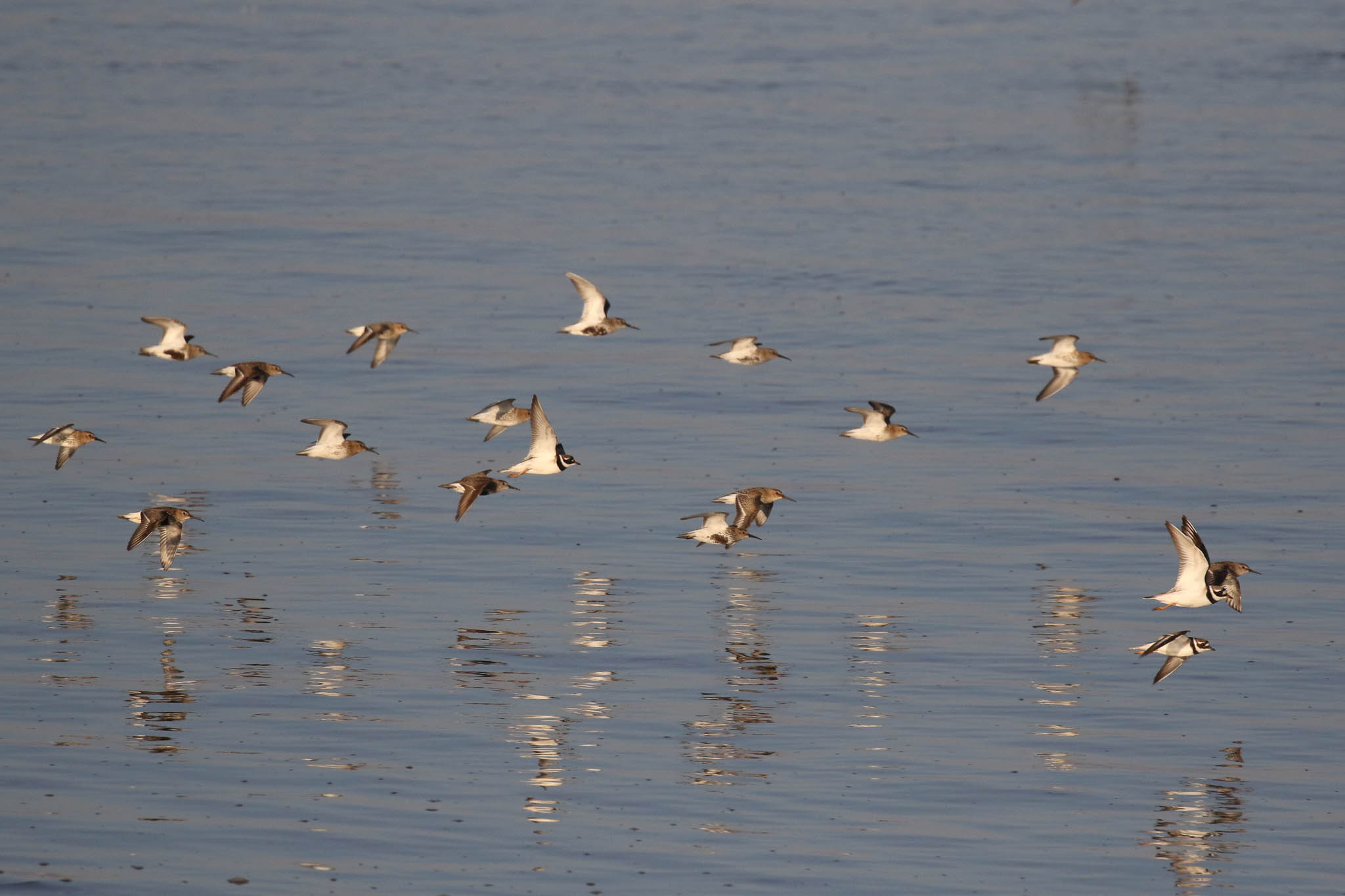
We moved on, further down the seawall towards Rotary Hide where we stopped again for another scan. We got the Oystercatchers in the scope now and could see them walking away from the rising tide, the flock appearing to move as one, to flow across the mud – the March of the Oystercatchers is always one of our favourite moments here.
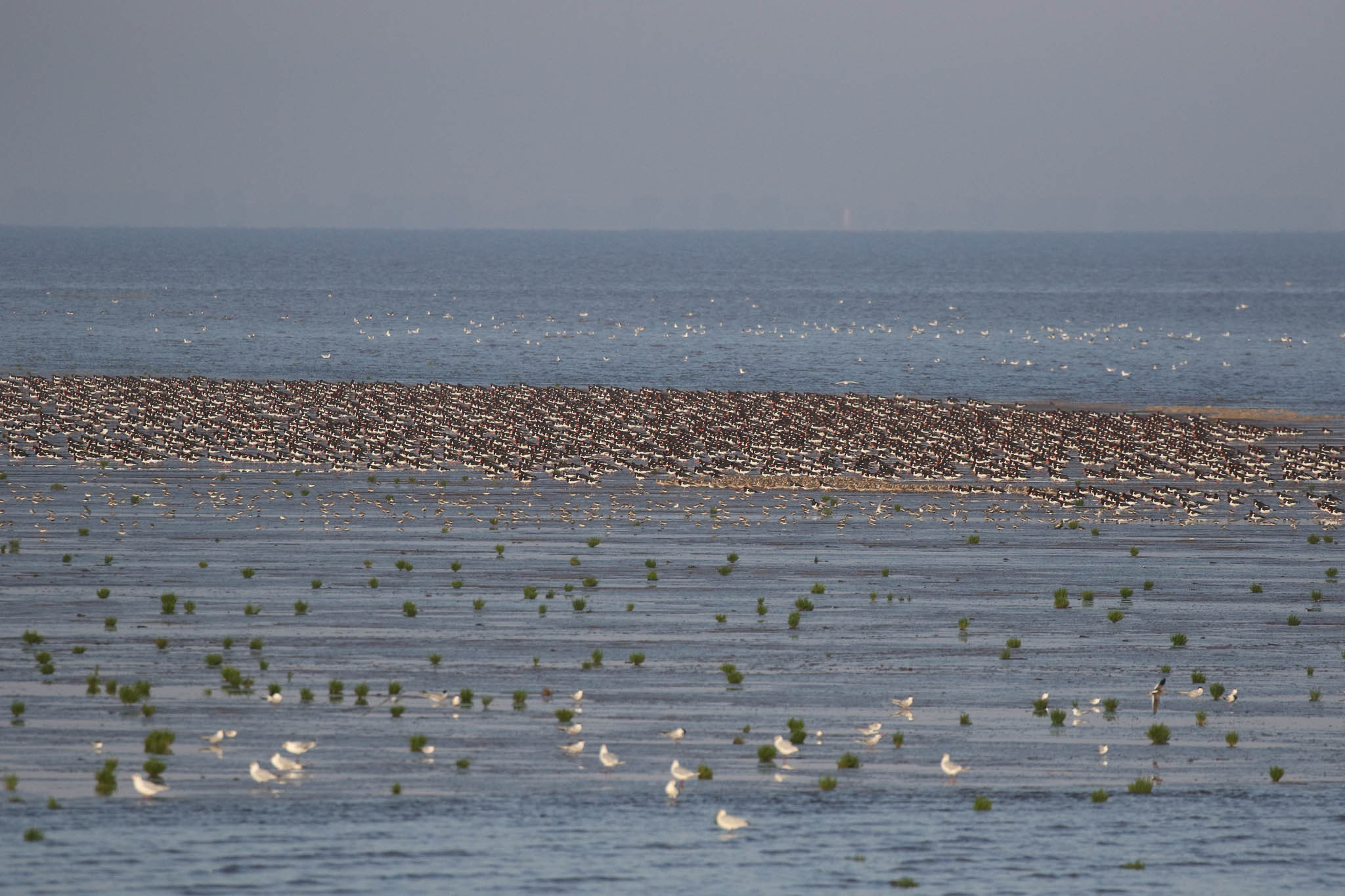
There were plenty of terns standing out on the mud too – lots of Common Terns and quite a few Little Terns with them too. An adult Common Tern with a fish in its bill flew past pursued by a fresh juvenile, another youngster still demand. Then they were off, flying further up away from the rapidly rising water.
Something spooked all the other waders and they took off and swirled round out over the water, twisting and turning. Speaking to the warden later, we learnt that there are around 30,000 Knot here at the moment, so it made for an impressive sight. Some of the Knot were already roosting on the islands on the Pit behind us – they had come in early today. We had a quick look at one of the islands from Rotary Hide, where thousands of Knot were packed in shoulder to shoulder. An Egyptian Goose was walking across the middle of the island and the Knot were pushing and shoving each other out of the way to clear a circle around its feet.
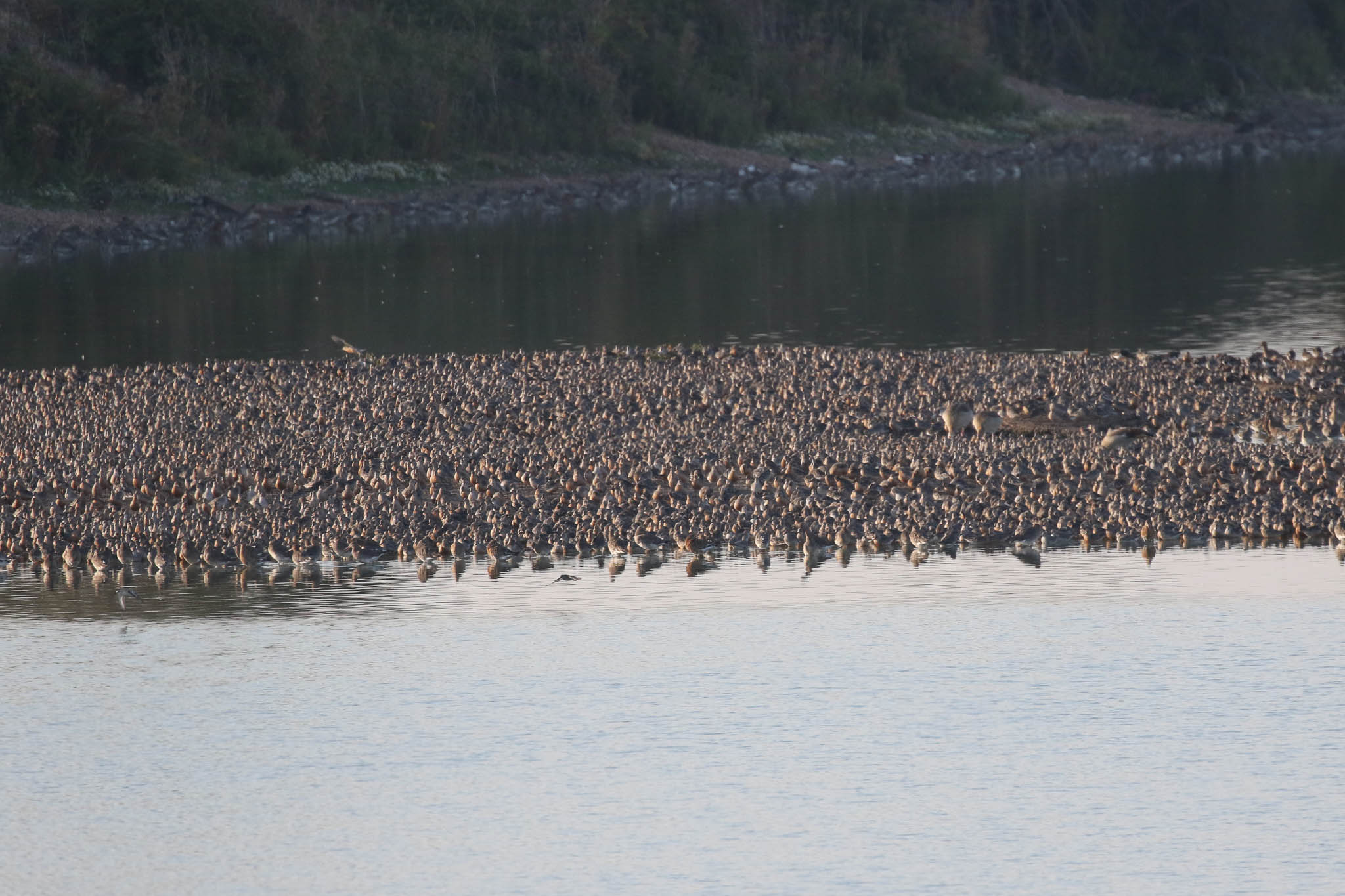
We couldn’t linger long in the hide, as the tide was coming in fast and we wanted to try to stay ahead of it. As we walked on along the path, a huge flock of Knot flew in high from the Wash, presumably some of the waders we had seen spooked earlier, and a stream of birds started to spiral down from the bottom of the flock as if a giant unseen vacuum cleaner was pulling them in, down onto the Pit to roost.
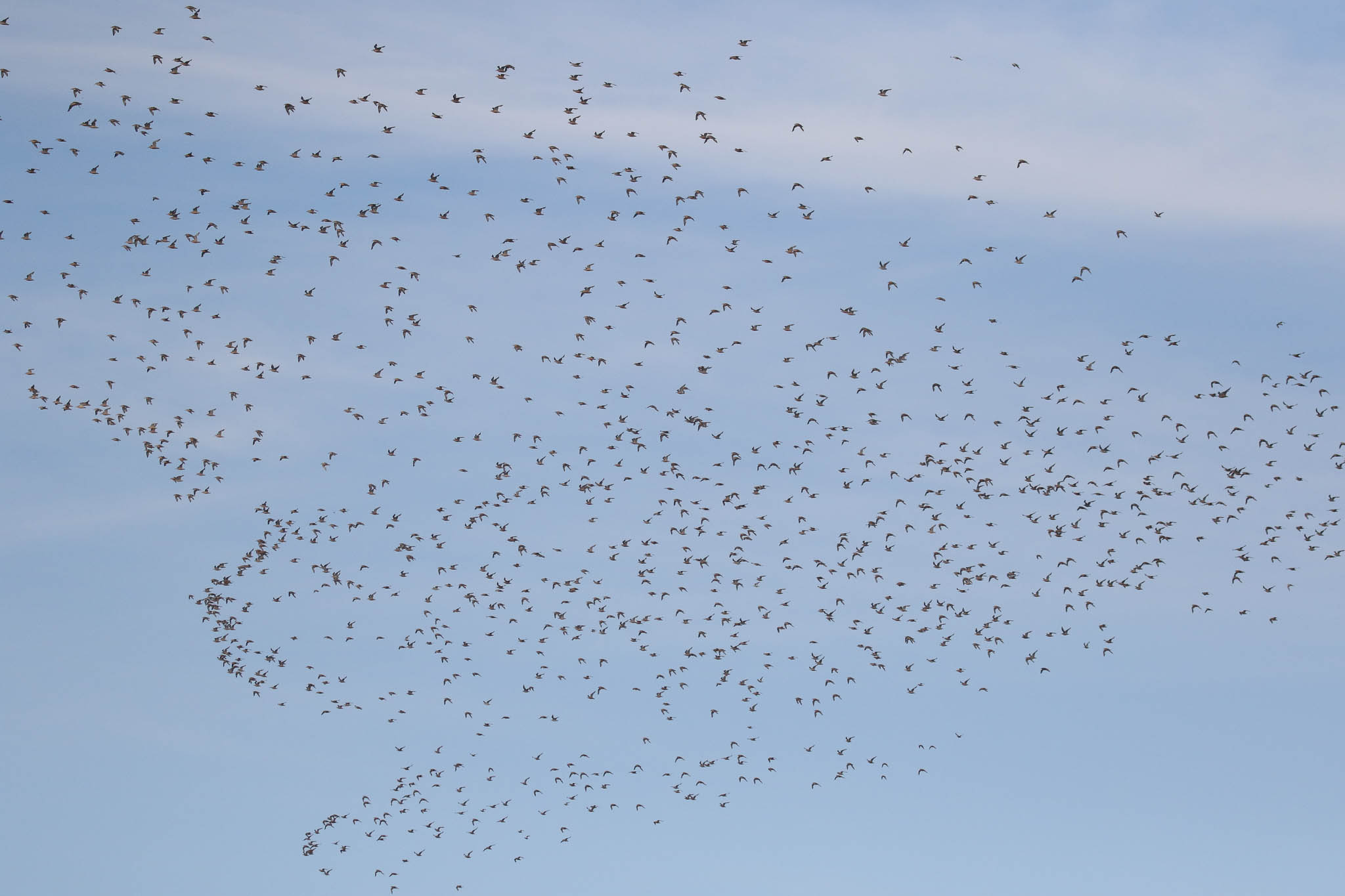
As we got down to the open grassy area opposite Shore Hide, the Oystercatchers were already giving up fighting the rising tide and flying in to roost. In typical fashion, a succession of lines of birds took to the air and came in piping noisily, over our heads. A Common Sandpiper was picking along the shoreline in front of us.
There weren’t many Knot left out on the nearest mud now, but a huge flock came up from further out on the edge of the Wash, possibly flushed by a distant Marsh Harrier or just forced up by the tide. Some tried to land in the last remaining corner of mud, which was increasingly packed with all the Curlew and Bar-tailed Godwits and the last remaining Oystercatchers, like King Canute, trying to hold out against the inexorable tide. Most of the Knot came straight in over our heads and spiralled down onto the Pit behind us.
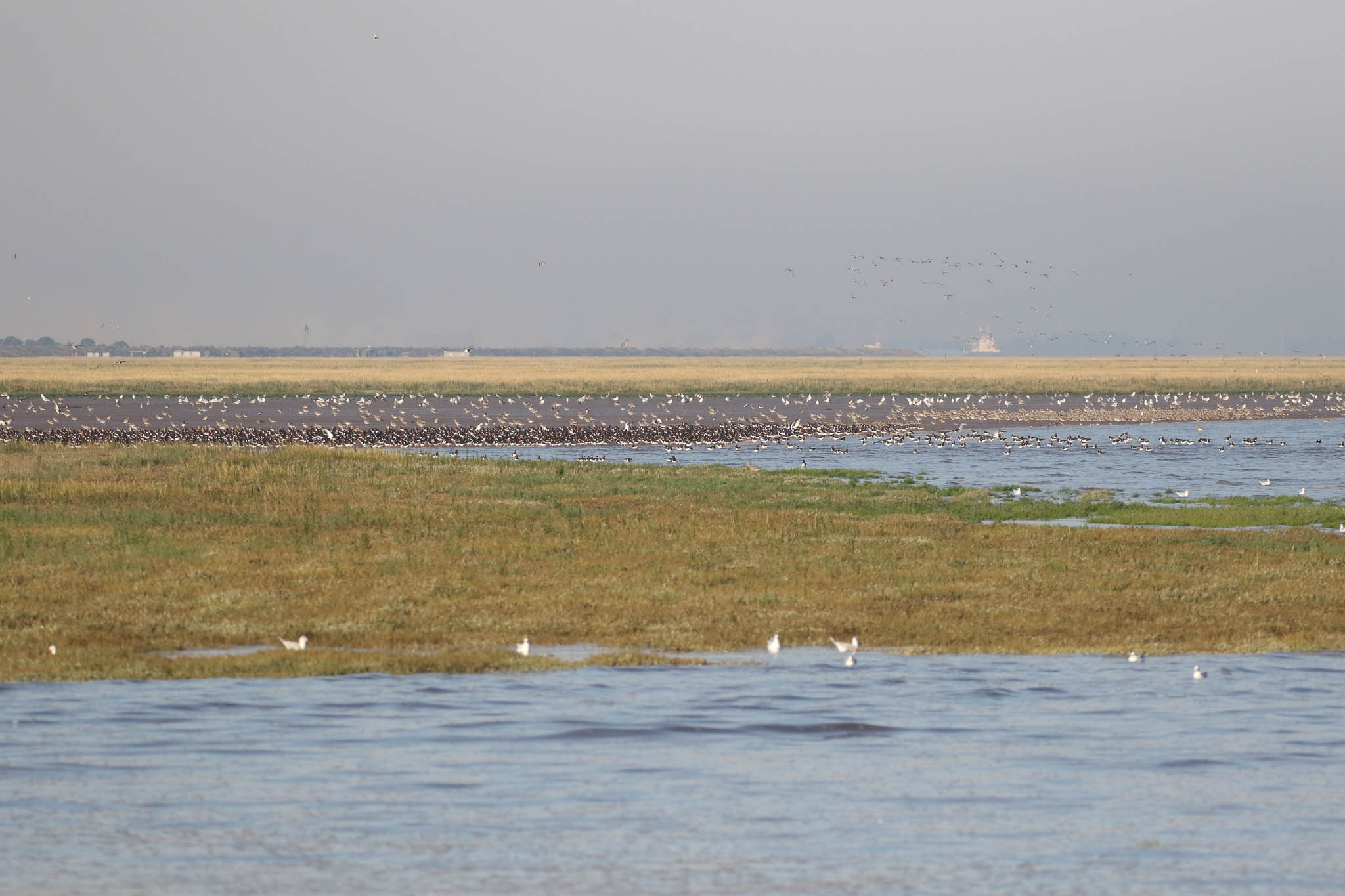
The Curlews and Bar-tailed Godwits will roost out on the saltmarsh – being much bigger, they are not afraid to roost in the grass. As the water covered the last of the mud, the Bar-tailed Godwits and some of the Curlew took off and flew round before dropping down into the middle of the saltmarsh. Most of the Curlew seemed to walk up into the vegetation next to the mud and we got some of them in the scope as the tide went slack.
After non-stop action since we had arrived, we could pause for breath now. We stopped to talk about the amazing journeys some of the waders had made to get here – from Scandinavia, arctic Russia, Greenland and even arctic Canada. A small flock of Swallows flew past, heading south, on migration already, next stop Africa.
There were quite a few Shelduck out on the water now, presumably some local birds and others come here at this time of year to moult. There were lots of small gulls too, and looking through the Black-headed Gulls we found a couple of Mediterranean Gulls with them and got the scope on them. Some of the terns were flying up and down now – a smart adult Common Tern flew past close and several Little Terns chased up and down a bit further out.
After the initial rush, the crowds in the hides seemed to be thinning out a little now, so we made our way round to South Screen. There were a few Meadow Pipits in the grass by the path which flew up ahead of us and we stopped to admire a male Stonechat perched on the top of the suaeda opposite the start of the boardwalk.
From the hide, the Oystercatchers were all packed in, roosting on the shingle bank out to our left. There were lots of Dunlin down in the shallow water in front of the hide and more along the shore off to the right. On the next island back, the Dunlin were mixing it with lots of Knot, most still in their smart orange breeding plumage, and a few Black-tailed Godwits which towered above them. We had a nice view of them through the scope.
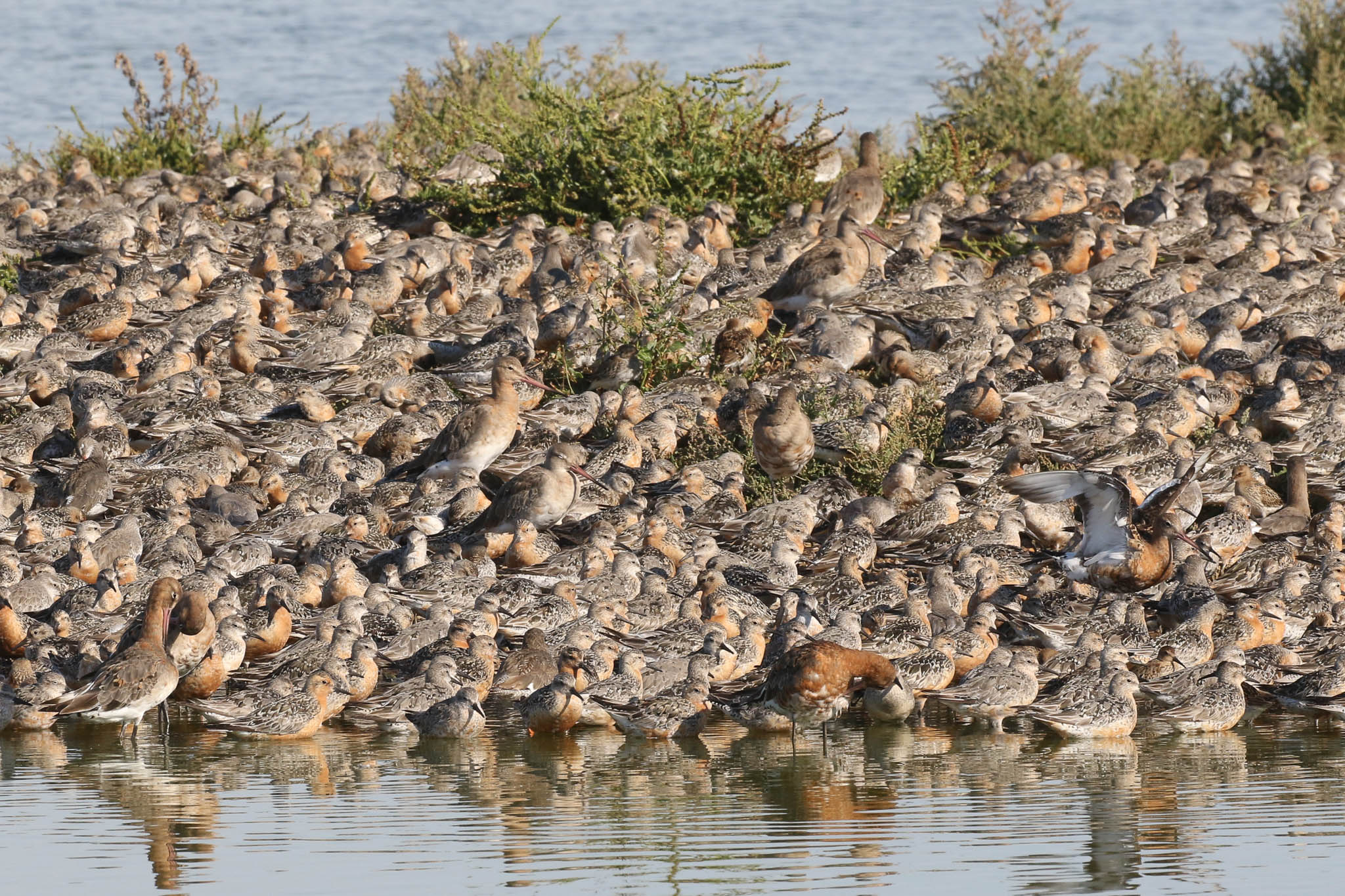
There were lots more Knot roosting on the islands at the other end of the Pit and now something spooked them. They all took off and started to whirl round, flocks moving left and right in front of each other, some went back out towards the Wash but the tide was still too high. Quite a sight! It seemed to be a false alarm so most gradually filtered back in, most landing back on the islands at the north end of the Pit, but others came in and landed on the islands down at our end. Many of the Dunlin, which had been mixing it with the Knot earlier, were barged out of the way and now forced to find somewhere else to roost.
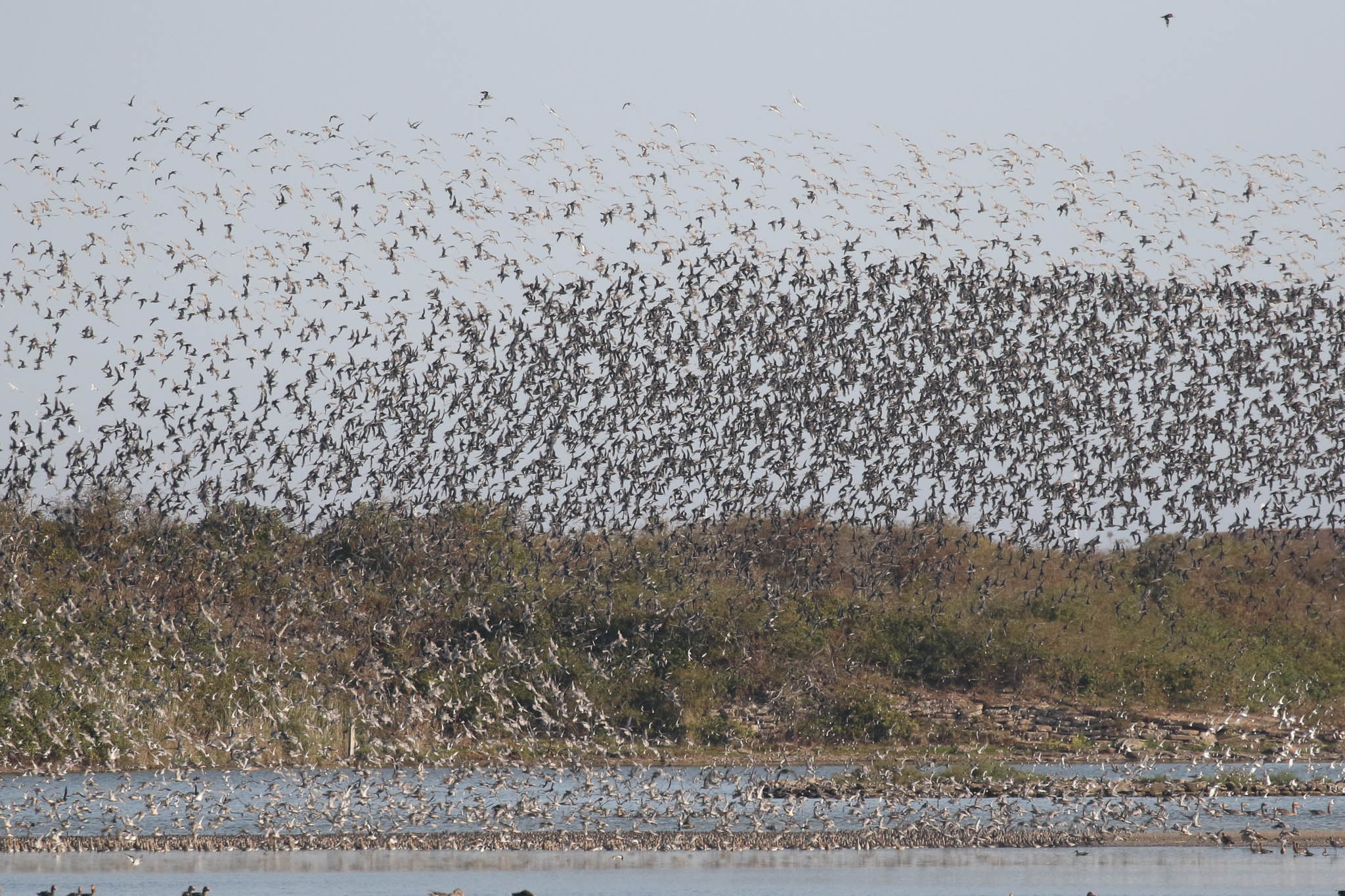
One of the group had gone on earlier to the new hide, ‘Knots Landing’, so we now made our way round there to regroup. Albeit through the one-way glass, there were some very close views of Dunlin right down in front of the hide, a rather sickly looking Egyptian Goose on the shore and a couple of eels in the shallow water. A Common Sandpiper was picking its way around the edge of the water in front of us.

Scanning through the Dunlin and Knot roosting on the islands we spotted a small wader which was greyer than the others with a white belly and neat streaks down its flanks – a White-rumped Sandpiper! One had been reported here two days ago but not seen yesterday, so this was a real bonus to find it here again today. White-rumped Sandpiper is an annual visitor to the UK from North America in small numbers.
We got the scope on it, but not everyone got to see it before suddenly all the waders spooked and took off. The flock of Dunlin split in three, two groups flew round in different directions and landed again but quite a few birds disappeared off up the Pit. When things settled down again, we scanned through the Dunlin we could see on the island but couldn’t see the White-rumped Sandpiper now.
We thought it had gone and were packing up to leave when someone else in the hide spotted the White-rumped Sandpiper again, emerging from behind the legs of a Black-tailed Godwit. It settled down on the stones to sleep and we quickly got it in the scope again – this time everyone had a chance to get a look at it. The a Coot walked along the back edge of the island and flushed everything again and the White-rumped Sandpiper didn’t return this time.

The tide was starting to fall already now so we made our way quickly round to Shore Hide. A few Oystercatchers and Knot were beginning to drift out from the Pit, back towards the Wash already. From the hide, we could see a lot of Knot were still packed tightly, shoulder-to-shoulder on the islands further up. A quick look through the Greylag Geese and Cormorants on the rocks in the middle of the Pit revealed at least three Spotted Redshanks roosting in between them. Two were already in silvery-grey non-breeding plumage, but one was still partly in breeding plumage. Through the scope we could see their long needle-fine bills.
We headed back out to the edge of the Wash for the return leg. There was already quite a bit of wet mud which had reappeared, and the waders which had roosted out on the saltmarsh, the Curlews, Bar-tailed Godwits and Grey Plover, had spread back out so we got them in the scope. Some of the Grey Plover were still looking stunning in their breeding plumage.
The Oystercatchers were flying up from the south end of the Pit in small groups, over our heads and back out to the mud. We were looking the other way when we heard a whoosh and turned to see a huge flock of Knot come up over the bank behind us. It was mesmerising as several thousand flew low over our heads, all we could hear was the beating of thousands of wings, and we watched as they flew out and landed on the mud.
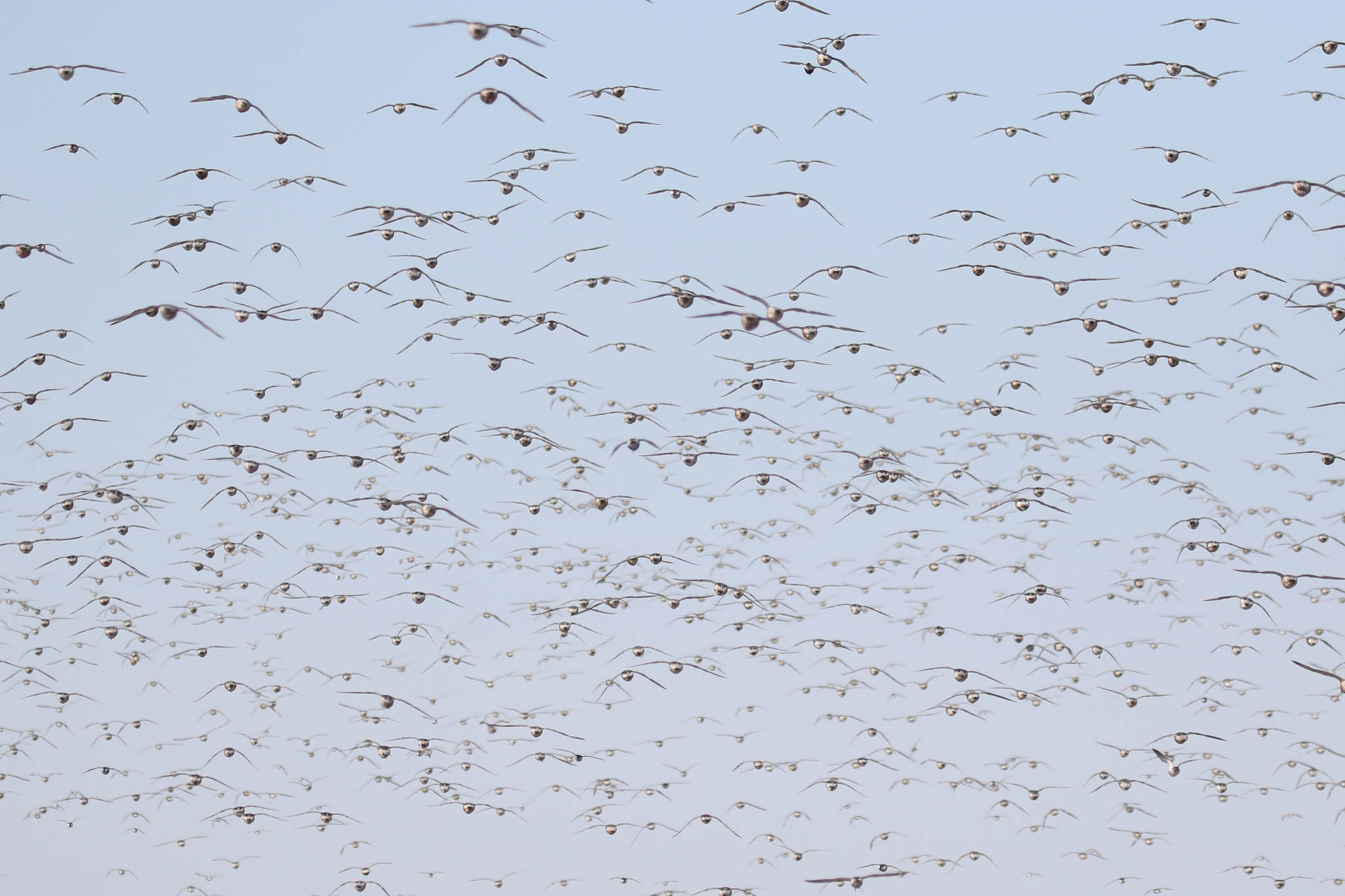
One smaller line of Knot came up from further up the Pit beyond Shore Hide, flying low over the bank and the path and out over the water. They were followed a little while later by another, even bigger flock which did exactly the same thing, making a beeline from the Pit back to the Wash.
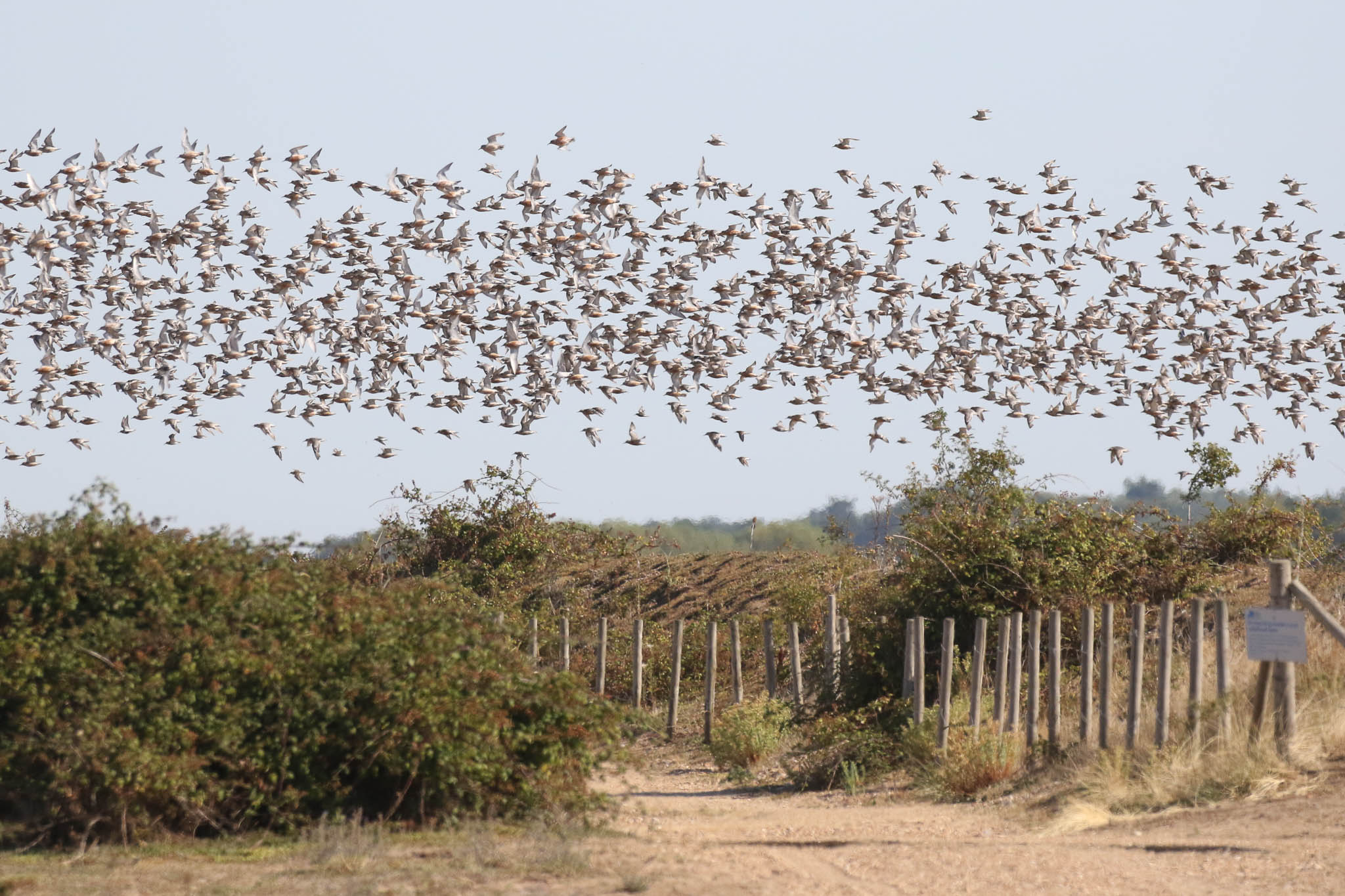
After a while, things started to calm down so we turned our attention back to the birds on the Wash. There was a large group of Oystercatchers out on the mud in front of us now and scanning across we could see lots of Dunlin scattered around them. We started to check through them in the hope of finding something different and what should we come across than the White-rumped Sandpiper again. We put a message out to say it was here and several other people who were on site managed to get over to see it now.
One of the group had earlier asked if there were any Golden Plover around and as we had one last scan through the waders in front of us we found a single bird out on the mud. Its gold spangled upperparts shone in the sunshine.
There were no more Knot coming out from the Pit now, so we decided to head back. We made our way across to Titchwell next, cutting across inland to avoid all the traffic on the coast road.
After an early start, we still had a bit of time before lunch when we arrived at Titchwell so we decided to go for a quick walk round via Patsy’s Reedbed first. As we walked down towards the Visitor Centre, we could hear a couple of Chiffchaffs and a Blackcap calling in the sallows and there were more Chiffchaffs in the trees along Fen Trail.
Patsy’s Reedbed held a selection of ducks, the drakes in dull eclipse plumage now, including Common Pochard, Gadwall and Mallard. A Kestrel was hovering over the long grass behind the viewing screen and a passing Sparrowhawk stopped for a brief spar with it before continuing on over the Tank Road.
It was getting hot now, so we didn’t linger too long and continued on around to the Autumn Trail and the back of the Freshmarsh. As we passed, we could see a male Emperor Dragonfly and several Ruddy Darters on the edge of the dragonfly pool. A Green Woodpecker yaffled from somewhere in Willow Wood.
As we approached the end of the Autumn Trail, two Bearded Tits came up out of the reeds but unfortunately flew straight over the path and disappeared over the bank towards Brancaster Marsh. This can be a good spot for them, but these were the only two we saw here. There were a few Reed Warblers and one or two Reed Buntings flitting around in the reeds.
Scanning the back of the Freshmarsh, we could see several Ruff and a few Avocets. A small group of Dunlin and Ringed Plover disappeared into the far corner out of view. On the shore of the big grassy island we spotted some more Golden Plover, at least eight, with several still sporting their summer black bellies. Then it was time to head back round for lunch in the shade in the picnic area.
After lunch, we had a quick walk out to the main hides. There were several Migrant Hawker dragonflies hawking round the pools below the path on the edge of the reedbed. We were almost at Island Hide before we heard a Bearded Tit calling. We looked over just in time to see it dart across over the reeds and disappear down not far out from the path, but despite waiting a few minutes we did not see or hear it again.
While we were standing and scanning the reeds, we put the scope on a group of 10 Spoonbills sleeping on the new bank in the middle of the Freshmarsh. A single Great White Egret was with them, busy preening and flashing its long yellow bill.
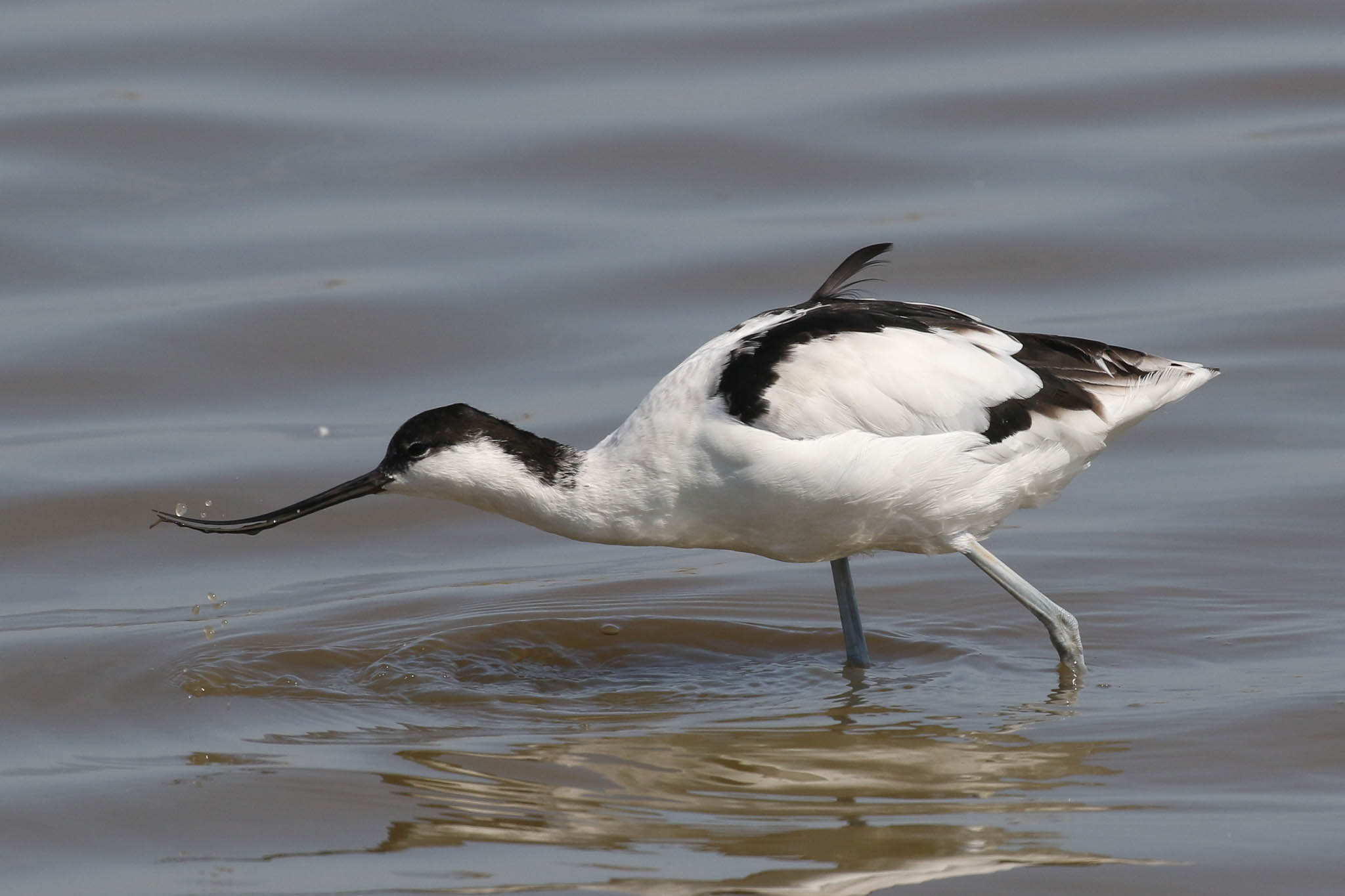
It was nice and cool in Island Hide, out of the sun and with the light breeze coming straight in through the open flaps. We had great views of several Avocets, Black-tailed Godwits and Ruff right in front of the hide. Scanning along the edge of the reeds, in case we could find the Bearded Tit from here again, we found a smart Common Snipe busy probing in the mud.
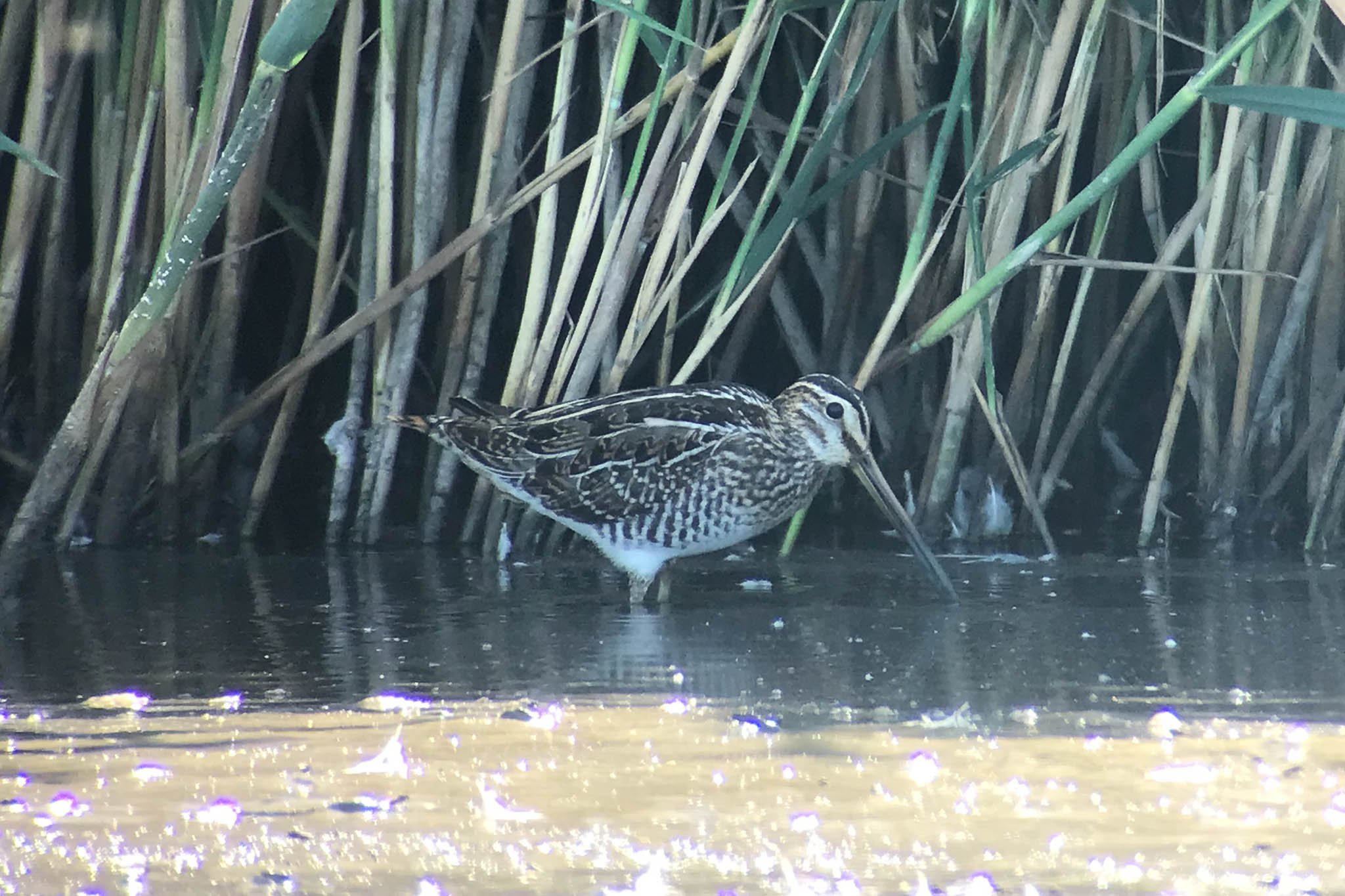
There were lots of gulls loafing around out on the Freshmarsh. In with a small group of Lesser Black-backed Gulls we found a single adult Yellow-legged Gull – paler grey backed but with bright custard yellow legs.
We didn’t have time to get right out to the beach this afternoon, but we did walk round to Parrinder Hide to see if we could find anything different over the back. The next compartment of the Freshmarsh by the main path is pretty dry now, but there were a few wagtails around the one remaining pool of water. A single Yellow Wagtail landed briefly with the Pied Wagtails before flying off. As we walked on, we kept hearing it flying round, but it seemed to be out on Volunteer Marsh now and didn’t drop in again.
We had a quick scan from the balcony by Parrinder Hide but there were no more waders on the back of the Freshmarsh that we hadn’t seen earlier. We did get another look at the Spoonbills from a different angle and a little closer. Then unfortunately we were out of time – after our early start this morning, it was time to head back now. It had certainly been a Spactacular day!
















